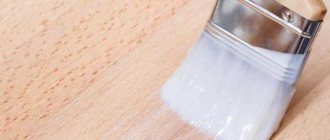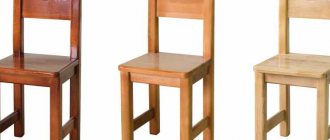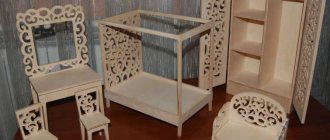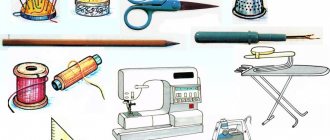What types of chair covers are there?
Chairs decorated with covers are found in a wide variety of interiors. Covers are used to disguise any imperfections in furniture, to improve its functionality and as a stylish decoration. There are several types of such covers.
- Solid. The product completely hides the chair, leaving only part of the legs visible. Well suited for masking furniture defects. It features the most complex cut and sewing.
- Half covers . Only the seat and back of the chair are covered.
- Separate. They consist of two elements, one of which is put on the back, the other on the seat of the chair.
- For the back . Covers only the top of the chair. Very often used as holiday decor. Extremely easy to sew.
- For sitting . Most often it is performed in the form of a soft pillow, which makes sitting more comfortable.
Covers of any type are made according to individual patterns; there are no universal options.
Photo: Instagram heimtextilien_almaty
Textile accessories in the interior
The style of the interior is determined not only by its significant touches - such as the color and texture of the walls or the choice of furniture, but also by accessories. A special role is played by textile accessories that can add the necessary color accents, “dilute” the design of the room or, on the contrary, tie together several shades used.
The modern market allows you to easily purchase any textile, but you can achieve a truly exclusive and original design only if you give preference to hand-made items, that is, made by hand.
Interesting! You can look at the design of the chair seat in a store or on the Internet, and then implement the idea with your own hands.
Unlike furniture, textile items can be changed at least every month
Some stylistic trends imply the presence in the room of stools or chairs with hard seats (for example, wooden or with a metal frame). To add comfort to such furniture, it is enough to place soft seats on a hard surface. In addition, such accessories allow you to change the design of the room as you wish. So, you can sew sets of such seats for different seasons (in winter - with Christmas motifs, in summer - green, and so on) or simply have two or three options in different colors.
Interesting! If you are good at sewing, you can make reversible seats. When you get tired of one color or ornament, you can simply turn out the cover and transform the room in a matter of minutes.
Overhead seats are much easier to care for than upholstered chairs, because they can be removed at any time and put in the washing machine. This option is well suited for decorating chairs in the kitchen, children's room, and hallway.
Seats on chairs can either duplicate the main textiles or stand out
Recommendations for fabrics for making textile seats
First of all, you need to correctly select the fabric from which the seat will be made. A soft pad plays not only a decorative role, but also a functional one, so the material for it must be resistant to friction, wear-resistant, and can withstand frequent washing.
Table No. 1. Fabric options for making seats.
| View, illustration | Description |
| Faux suede | Practical material that is very pleasant to tactile contact. Artificial suede has a very reasonable price, attractive appearance (there are hundreds of shades of this fabric), it is durable, easy to clean, and when treated with a special Teflon impregnation, it also becomes moisture-resistant and does not get dirty for a long time. It is enough to wipe such a seat with a damp cloth to remove minor dirt. |
| Flock | Durable non-woven material with a pleasant surface. This fabric has good breathability, is wear-resistant, looks expensive, but at the same time is practical. Flock chair cushions will be appreciated by pet owners - if a pet jumps on such a seat, it will be very easy to remove its fur by walking over the surface with a wet hand. At the same time, the flock tolerates frequent use well; it is difficult to leave a snag on it or tear it. |
| Artificial fur | A good option for pillows that will be used during the winter season. Faux fur looks great, quickly returns to its previous shape as soon as a person gets up from a chair, and is easy to clean. To decorate the chairs, you can choose plain fur in a neutral or bright color, or choose original options that imitate natural furs - for example, leopard, giraffe or zebra. |
| Fleece | Lovers of cozy and warm fabrics will appreciate the fleece chair seat. Fleece is even called an artificial analogue of sheep wool - for its ability to retain heat for a long time. This is a hypoallergenic material that tolerates washing well, does not fade, and is abrasion resistant. In addition, this lightweight but durable material has a very delicate texture that is incredibly pleasant even to bare skin. |
| Microfiber | The fabric from which towels are often made is also perfect for creating a chair seat. Microfiber perfectly absorbs water, it is strong and durable, and does not lose its brightness over time. You don’t need to think that the pillow will have a “towel structure” - in stores you can find ultra-thin microfiber, the fibers of which will be almost invisible. A microfiber seat is well suited for the kitchen or nursery - in short, rooms where there is a high probability that something will spill or spill onto the chair. |
| Cotton fabrics | Cotton-based fabrics such as satin, calico or poplin are an ideal solution for summer time, as well as interiors where a romantic, light, even slightly rustic style prevails. Cotton types of fabrics are pleasant to the body, hygroscopic and do not cause allergies, are very easy to care for and are machine washable. The only disadvantage we can highlight is that the cotton material wrinkles easily - this must be taken into account, since the seat will constantly be wrinkled. But if you pull the fabric tightly, there will be no problem. |
| Linen | Linen fabrics are an exclusively natural material, and therefore will appeal to lovers of environmentally friendly, natural and hypoallergenic textile accessories. Seats made of linen will breathe wonderfully, absorb moisture, this material is pleasant to the body. Linen is suitable for sewing a pillow on a high chair for feeding a small child - it is a completely safe fabric, aesthetically pleasing and lightweight. |
| Denim | Dense and hard cotton material is perfect for making seats for chairs in a teenager’s room, or for the interior of rooms in the loft, hi-tech or minimalist style. Jeans can maintain an aesthetic appearance for years, withstands washing, does not fade or fade. There are many shades of denim - you can choose a snow-white version, classic blue, or any other so that the pillows fit well into the overall design of the space. |
| Carpet | An unusual material for making chair seats, but very practical and durable. It is worth choosing soft carpet options on a hard base - then the pillow will be tactilely pleasant, at the same time durable and reliable. This seat does not deform and will not lose its visual appeal even during constant use. |
Having decided on the fabric, you need to pay attention to the choice of colors. It just seems that the cushion on the chair seat is a small thing. In fact, this accessory can become a necessary color accent or a full-fledged participant in the interior and decor of the room. It is better to combine chair seats with other shades already present in the design. Thus, textile decor can overlap with curtains or carpet, tablecloth or fabric napkins. You can choose pillows to match the color of the sofa or bedspread.
Sewing a bedspread with your own hands is another way to save money and an opportunity to bring a piece of your soul into the interior. Detailed step-by-step instructions for making a bedspread can be found in our special article.
If there are any color accents in the room, you can also support them with pillows. So, with a neutral color of walls, curtains and furniture, you can have bright flower pots, an unusual colored chandelier or noticeable photo frames - sew the seats on the chairs in this color.
Important point! If you order curtains or a bedspread from a studio, think in advance whether you will need decorative pillows. Even if you don’t want to use textile chair seats at the moment, you can save a few pieces of fabric left over from sewing so that you can use it at the right time and create a design in a single color scheme.
The color of the seats echoes the color of the walls and the pattern on the tablecloth
Of course, chair cushions can be not only plain. The “patchwork” technique looks interesting, when the seat looks as if it was assembled from many scraps. The seats decorated with lace are interesting - they will fit perfectly into a room where a romantic interior predominates.
Fabric with polka dots or checks does not lose its relevance for many years, and if a bedspread or curtains with such a print seem too active to you, then chair seats will look great!
Reversible seat with different prints
It is worth considering that additionally you need to decorate the seats wisely. Yes, you can use lace fabric or embroidery, add appliqués to the finished product, or sew on fabric-covered furniture buttons. Other decorations, for example, bows or rhinestones, although they will look original, will seriously damage the functionality of the product.
Prices for various types of flock fabrics
Flock fabric
Video – Decorative seats for chairs
Prices for different types of fleece fabrics
Fleece fabric
Which seat filler should I choose?
Of course, fabric alone will not be enough to make a comfortable seat. Only the cover is sewn from textile material and placed on a soft base. There are several options for fillers, let's look at them in table form.
Table No. 2. Fillers for seats on chairs.
| View, illustration | Description |
| Sintepon | Light, elastic, but at the same time voluminous filler that is resistant to various deformations. Sintepon tolerates washing well and is considered a good option for stuffing a chair seat with it. |
| Foam rubber | The most common and inexpensive filler option. Foam rubber is available in various densities and thicknesses, so you can choose the ideal seat for each family member. The main advantage of foam rubber is that it is easy to cut, and the resulting part holds its shape on its own, serving as the basis for the cover. |
| Holofiber | Fibrous synthetic material in the form of small balls, can be produced either in the form of a sheet or in bulk. This is a hypoallergenic material, it is highly breathable, soft and elastic, but at the same time holds its shape well and does not deform. |
| Latex | Furniture latex is an elastic, comfortable and durable material - a seat filled with such filler will last eight to ten years without any problems. The disadvantages of the material are high cost and relatively significant weight. |
| Batting | Batting is an inexpensive, but natural and safe material that absorbs moisture well and allows air to pass through. Batting is even suitable for making children's mattresses, which indicates its high level of environmental friendliness. But, products made from batting have a significant weight, such a filler will take a long time to dry, and with frequent washing it can separate into layers. |
| Polyester | A synthetic fiber used to stuff pillows, blankets and even thin mattresses. A highly breathable, lightweight material, however, polyester has a lifespan of about three years, after which the filler may clump. |
| Polyurethane foam | The material is classified by hardness, so you can make both a very soft and quite elastic, hard seat for the chair. Thanks to perforation, polyurethane foam weighs a little, has good air permeability, and has a memory effect. |
Prices for various types of furniture foam rubber
Furniture foam rubber
Patterns and measurements
They begin to build a pattern by taking measurements. This is done using a flexible tailor's meter. We measure:
- back width and length:
- seat width and length;
- the desired length of the future cover, starting from the seat of the chair and from the back.
Photo: Instagram texvibe
If you plan to sew a cover that completely covers the legs, measure the distance from the seat to the floor. At least 1 cm must be taken away from it, otherwise the chair will be uncomfortable to use. The lower part of the cover will quickly get dirty and tear, and also interfere with moving the chair. In addition, you need to determine the size of decorative elements: ruffles, pockets, folds, etc.
After taking measurements, you can begin to create a pattern. For separate and integral models, the construction principle will be the same. The difference is that for one-piece covers the parts for the back and seat are connected, for separate ones they are not. We start building with a pattern for the seat. On paper, using the measurements taken earlier, we draw a figure that replicates the seat of the chair.
Photo: Instagram deco_lux_kz
On each side we add 1-1.5 cm to the seam allowances. We build the part for the back in the same way and also add seam allowances. Don't forget to add the length of the skirt if you have one. If it is assumed that the legs of the chair will be covered by a skirt, you need to create a pattern for it too. Determine the width of the part. Usually the skirt has pleats or gathers. Taking this into account, we calculate the length in this way.
Photo: Instagram decorweddingminsk
We calculate the total length of the three sides of the seat and add to it the allowance for gathering. Its minimum value is half the length of the frill. The result is easy assembly. Other options are also possible. For example, you can put a fold in the fabric, then unfold it and measure it. Then multiply the resulting length by the desired number of folds. This will be the desired fold allowance.
Photo: Instagram shtori_rostov
Choosing fabric for sewing
Sewing can be done from a variety of materials. It all depends on the final purpose of the cover. For daily use you need a practical and inexpensive fabric, and for the holidays you need a beautiful and elegant one. In addition, they take into account the room in which the chairs are located, its purpose and its own interior.
Important! For everyday use, you should choose a wear-resistant material that can be removed and washed or knocked out at any time. One of the criteria is also the absence of electrification and absorption of contaminants. Some of the best fabrics for sewing are considered to be cotton, microfiber, linen or silk.
Stylish case in light colors
Cotton fabrics
Among them, the priority is satin, calico, denim or twill. Their key advantage is that they hold their shape well, do not cause allergies in sensitive people and are machine washable. Cotton fabrics are inexpensive and come in a variety of shades, colors and patterns. They also have disadvantages: rapid fading and getting wet.
Cotton covers
Linen fabrics
These include matting, linen itself and canvas. They are environmentally friendly, highly durable, dirt-repellent and can be subjected to intensive machine washing and intensive use. Also, linen does not absorb dirt well, it is hypoallergenic and easy to care for. Rough, minimally processed linen fabrics are ideal for everyday slipcovering. The disadvantages are: difficulty in cleaning and ironing, rough texture. Linen covers are suitable for everyday use in country or ethnic style rooms.
Linen fabric looks practical but beautiful
Flock and microfiber
These materials are new generation materials. Their main advantages were:
- Wear resistance;
- Attractiveness;
- No creasing;
- No deformation when washing.
You might be interested in this About patterns and sewing clothes for a Monster High doll
Important! Despite this, microfiber and flock cannot be subjected to heat treatment: dry on a radiator and iron. This is not necessary if there is no creasing.
Microfiber chair cover
Silk
Silk fabrics include: brocade, satin, crepe-satin. Their advantages are that they are durable, noble and resilient. Silk fabrics make it possible to create spectacular folds and draperies. There are also disadvantages: high price, demanding care and washing, careful ironing. Such canvases are suitable for creating holiday covers in classical and neoclassical, Indian and Arabic styles.
Silk covers can emphasize the solemnity of the event
How to sew a chair cover: step-by-step instructions
Regardless of the shape and size of the product, the process of sewing different models of covers is approximately the same. It can be divided into several stages.
- We prepare small parts, if they are provided for in the model. We fold the ties with their faces inward, grind them and turn them inside out. We process the top edge of the patch pockets and sew them in place.
- We sew a skirt. We process the bottom edge of the product. Depending on the fabric, we use a hem seam or process the seam allowance on an overlocker and hem it. We lay folds along the upper edge, fastening them with hand stitches, or assemble them.
- We sew a seat. We fold the main part and the lining face inwards. If necessary, we place a piece of padding polyester or foam rubber on the latter. Place the top edge of the skirt between the base and the lining. Align the cuts and sweep away. Then we machine stitch, leaving the back of the seat unstitched. We turn the part through it and carefully straighten it.
- We sew the back. Place the lining and base face to face and place the ties between them. We baste them to the main part before placing it on the lining. As a result, the ties will end up in the side seams of the back. We sew the part without sewing up the bottom part. Through it we turn the product inside out and straighten the seams.
- We connect the two parts of the cover. We sweep together the finished seat and backrest. We sew a machine seam. If necessary, we process it using an overlocker.
- We sew on decorative elements, if necessary.
Photo: Instagram flora_decor.msk
Selecting material for the product
The material is selected depending on the purpose of the product. For everyday protective covers, fabrics that are more durable and easy to wash are chosen; for holiday ones, the desired shades and textures are chosen. Children's and decorative ones can be sewn from the remains of colorful fabric.
Cotton, linen or upholstery fabrics
Dense fabrics made from natural fibers or furniture types of fabric are most often used to decorate kitchen chairs or living room furniture. The selection is made in accordance with the style of the room, and furniture upholstery is selected based on its similarity to armchairs or sofas.
Synthetic knitwear, supplex
Stretch fabrics fit the most complex shapes well. They are used in modern styles such as modern or minimalism, where pretentious forms are not welcome. Plastic materials will help maintain the lines of the chairs and create the original look of the furniture.
Simple carpet seat
Carpet seats in the shape of a rectangle, covering the back and seat at once, are selected if the covers on the sofa and armchairs are made of similar fabrics. The pile material creates a feeling of a warm surface and softness of the product, giving the interior a cozy feel.
Seats made from patches
Patchwork is a good way to recycle numerous small scraps that are not enough to make a cover individually. Most often, contrasting squares and triangles are combined into a geometric pattern, and then a whole product is assembled from identical parts. For a chair in a nursery or kitchen, scraps can be used to make a fragment of a backrest or seat, decor, small details (a small skirt or frill, ties, etc.).
How to crochet a seat?
Do-it-yourself knitted chair seats are created from leftover yarn. You can use 2 main techniques:
- Knit a whole product (for example, a seat on a stool) in a circle from the center. For a square chair, at 4 points, begin to add several loops on each row, gradually forming a square. When going to the outer contours of the seat, the direction of knitting is changed and the skirt is knitted like any straight product, from the same number of loops in each row.
- First, many hexagonal or square parts are knitted according to the chosen pattern. Making a seat using this method is reminiscent of the patchwork sewing technique. The prepared elements are crocheted into a common fabric. Using Irish lace knitting techniques, you can make an original cape with a floral pattern.
DIY chair covers for the kitchen
For kitchen chairs, seat covers are most often sewn. To prevent the product from slipping on furniture, it is supplemented with ties or Velcro. Cutting such a cover is very simple. Measure the width and length of the seat and build a rectangle. Add seam allowances on all sides. The pattern is ready. After which you can cut the product and proceed to sewing:
- We place the soft interlining on the main fabric from the inside out and baste it or pin it together. We apply ties and attach them to the base.
- We fold the base and lining with the right sides inward, align, chop or baste.
- We sew three sides of the future cover.
- Turn the product inside out and carefully straighten the seams.
- We sew up the area through which the cover was turned inside out.
If necessary, we decorate the product. The cover for the kitchen chair is ready.
Photo: Instagram viktoriamagamedova
Decoration options
The style of the interior in which the chair will stand dictates the methods of decoration. Laconic minimalism or modernism do not tolerate overload, but will accept a combination of fabrics by color or texture, discreet details: pockets, folds. To decorate cases in a classic interior, the following are suitable:
- long frills;
- edgings emphasizing the clarity of the form;
- thin golden or woven braid;
- imitation of antique lace.
This trend is generally characterized by ceremonial decor and regular geometric shapes.
Rustic style, country and Provence suggest natural fabrics and very cozy finishes:
- frills, ruffles;
- crocheted lace;
- braid with ornament;
- lacing.
Making a bar stool with your own hands, instructions for three models
In banquet halls, chair covers with backrests are decorated according to the general style of the room. Beads, satin ribbons, rhinestones, and brooches are used for decoration. Artificial or fresh flowers will also come in handy.
Such “clothing” for furniture will protect new chairs and stools from dust and damage, and will give old ones another chance. In addition, hand-made chair covers will add comfort and beauty to your beloved home. And if you create several sets, then with their help you can update the interior every season.
We sew a cover for the back of a chair with our own hands
To create a pattern, you will need to measure the width and length of the back. The pattern will be a rectangle. Its upper part can follow the shape of the back of the chair, that is, be either straight or rounded. Seam allowances must be added on each side. For the cover you need to cut out two parts from the main fabric. The product is worn on the back, so one side is not sewn up. Let's look at the sewing technology.
- Place the pieces with right sides facing each other, align the cuts, and baste. You can carefully pin it with pins.
- We sew three sides of the cover, leaving the bottom part unstitched.
- Turn the product inside out and straighten the seams.
- We hem the lower part of the cover with a hem seam either by hand or by machine.
The product is ready. You can decorate it in any suitable way. Knitted covers look very good. One of the possible options is in the photo below.
Photo: Instagram surovaya_nitka











